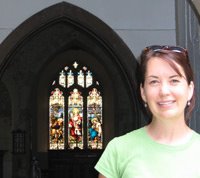37: Abbey silence

My welcome to Hampshire was soft and quiet—the dusky air, the green trees overarching the stone buildings of Alton Abbey.
My cab pulled into the parking lot at exactly the wrong time, around ten to eight. (“Right, Jane Austen. So you’re American, yeah? Always the Americans—and the Japanese, too—tourists, coming to see Jane Austen stuff. Don’t understand it myself, ” William, the driver, said in a thick-ish and to my untrained ears, working-class accent.) The brothers were in the chapel praying, or meeting. Dom Nicholas, the guestmaster, heard my car and came to meet me, slightly bent, feet moving fast beneath his ankle-length black robes.
“Mrs. Smith,” he called me. I guessed that he might be somewhere between sixty and seventy, maybe closer to the higher end, with whitening hair and softening skin. He is about six feet tall, on the thin side, and carried my terribly heavy bag up the stairs before treating me to a half-whispered tour with his Irish lilt.
My room spoke of solace—terribly clean, a worn parquet floor, two twin beds with duvets, a large window overlooking the wide lawn and rose garden. The monks’ quarters were down the hall, behind a closed door. Should I need anything at night, he said, after they had closed themselves up, all I needed to do was knock on their door.
The Abbey itself is big and meandering. It must feel small to the six or eight men who live there—the Abbot has been there forty years, I think—but it took me a while to get my bearings. The hall and wide stairway outside my room have windows looking out on a central stone courtyard, with benches and water plants and a fountain. There is a huge great room, with five or six couches, bookshelves with games, big chairs, and old-fashioned bay windows looking out onto the garden. Next door is the dining room, where our meals would be taken in silence. Around the corner and down a hall is the entrance to the church, which forms one side of the seemingly square structure.
I was very afraid that I would inevitably do something to offend the monks. Their goal is to welcome all as they would welcome Christ, and I knew I was welcomed here—yet they live by a strict code, with which I was largely unfamiliar (aside from my reading Kathleen Norris). They must often experience a tension between their Benedictine way and their ignorant guests.
Dom Nicholas showed me the bathroom down the hall, still in an earnest whisper, charging me to remember to leave the rubber shower mat out to dry on the edge of the tub, rather than on the heater where it would melt. He graciously brought me three small towels since my own was dirty, and asked several times to make sure I had soap.
I joined them in the church for evening prayer at 8:30. There were three English women also staying here, on retreat, so the four of us sat in the first row. Dom Nicholas told me where I would find the prayer book, the order of worship, on the table against the wall on the right hand side. But I didn’t see it, so the Abbot himself came down in the silence before the service started to get it for me, opening it to the right page.
The prayers were comforting, Psalms read responsively, the left side leading with the three brothers who were sitting there. We women followed Dom Nicholas and Andrew, and a visiting nun here at the Abbey on holiday, who sat on the right of the raised platform, facing the brothers at the other end. The readings were almost chanted, in a strong monotone that seemed to heighten their English accents. There were a few melodies, led by Father Luke with no accompaniment. We sang a simple hymn as the day closed and the sky darkened, and then the monks filed out, raising the hoods of their robes.
I felt as though I had entered the silence.



0 Comments:
Post a Comment
<< Home